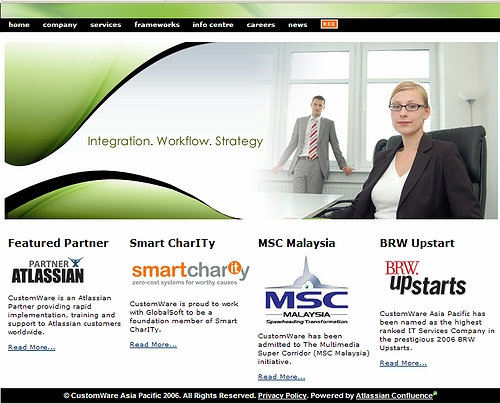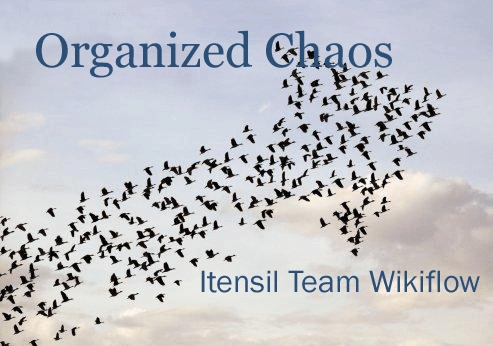Rod Boothby is running a Read/Write Intranet Idol – it’s a poll I invite you to participate in, so I am attaching it at the bottom. But first, it gives me a chance to share some of my (wiki)-thoughts.
The list is a mix of industry behemoths (Microsoft, IBM Lotus), emerging but established brands (Atlassian‘s Confluence, Socialtext, WordPress), relatively known startups and quite a few obscure names. The latter probably not by pure chance: both Rod and I are on the Selection Committee for the next Under the Radar Conference on Office 2.0, and scouting for candidates we have made quite a few new discoveries, including some of these “obscure” names, that likely won’t remain obscure for long.
 Perhaps the biggest “discovery” for me was Brainkeeper, a user-friendly enterprise wiki startup that officially launches today. Totally out of left field, they aim to be like market-leader Confluence in functionality yet have a friendly UI like Wetpaint. Oh, and add niceties like Workflow (Itensil?) and an API. Like I said before sometimes it pays to *not* be first on the market …
Perhaps the biggest “discovery” for me was Brainkeeper, a user-friendly enterprise wiki startup that officially launches today. Totally out of left field, they aim to be like market-leader Confluence in functionality yet have a friendly UI like Wetpaint. Oh, and add niceties like Workflow (Itensil?) and an API. Like I said before sometimes it pays to *not* be first on the market …
It was really interesting to watch the poll dynamics change yesterday and this morning. First, with only a handful votes cast unknown little Brainkeeper was leading the chart. Another leader was Koral, a content collaboration startup I’ve been planning to write about way too long now (until I pull my act together, see two reviews by Ismael and John Wilson). What’s content collaboration? It’s content management without the pain of “management”. As much as I am a fan of wikis, not all companies will embrace them: Koral helps those who mostly work with desktop documents (MS Office) share, update, collaborate painlessly.
Back to the poll: as more voters came in, predictably the “brand names” strengthened their position and the “obscure” ones fell somewhat behind. Still with 117 votes cast, I believe it’s mostly InnovationCreators’s primary reader-base, where Microsoft Sharepoint or Lotus Notes Blogsphere are not exactly popular. Like it or not those products will make a killing on the corporate market. So “brand name” here means the likes of Confluence by Atlassian, Socialtext, WordPress, Movable Type…etc.
Confluence’s #1 position on the list reflects it’s real-life market position: absolute leader in market share, revenue, functionality. Of course to maintain that position they can’t just sit on their laurels and they know that. At a really productive meeting with the San Francisco team recently we discussed their development plans, most of which I cannot share for now. However, I am happy to share that in the not-so-distant future Confluence will offer a hosted version – something I’ve repeatedly asked for:-).
As for competitor Socialtext, they revamped the product a few months ago: while I was fairly critical of some of the functional misses, the single biggest improvement was the UI: they went from an outright ugly product to a pleasant-looking, clean, friendly one. In fact this, along with other players (JotSpot, Wetpaint, Zoho, Brainkeeper) has turned the table: formerly good-looking Confluence now feels a bit … well, 2005-ish (?) Still the best, but somewhat boring. They are keenly aware of this and improving the UI is one of Atlassian’s key priorities.
JotSpot is in hibernation in the meantime, although TechCrunch speculates it may open up soon. Zoho is a newcomer to the wiki space, but not one to underestimate: they may just leapfrog all other players when they tightly integrate their full Suite (Write, Show, Sheet, Create) thus creating a truly powerful read/write/collaborate platform online.
Last, but not least two smaller wiki-players from the list: Itensil combines workflow with a wiki (now, religious wiki-fans deny the need for any structure or workflow, which is probably OK for a small group, but workflow is the way large corporations work), and System One combines a wiki with relevant enterprise search.
Without further ado (wasn’t this enough?) here’s the poll, please cast your vote:
You can click “view results” after you cast your vote, then “Complete results” to se more stats on the Zoho Polls site. Once there, click the “Rating” header to sort the list in ranking order – right now, with 117 votes cast Confluence is #1 with an average of 3.54, closely followed by Brainkeeper’s 3.50.



 You Know Wikis Have Arrived When …. they become the feature post in your regular junk mail – this time from an Executive Recruiter firm:
You Know Wikis Have Arrived When …. they become the feature post in your regular junk mail – this time from an Executive Recruiter firm:


Recent Comments